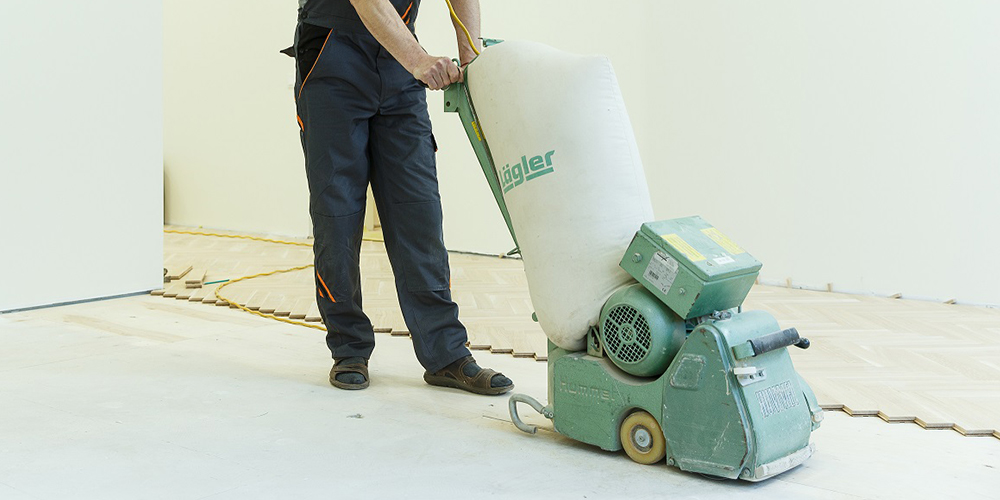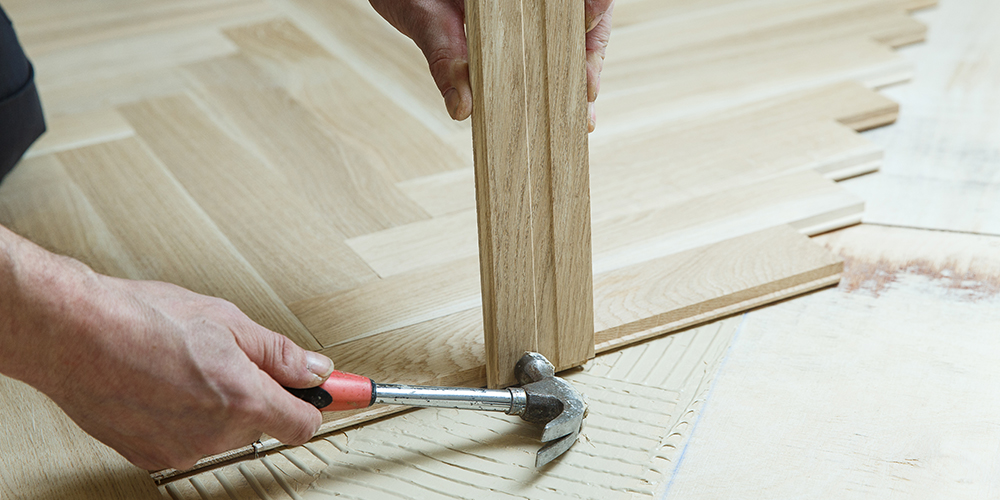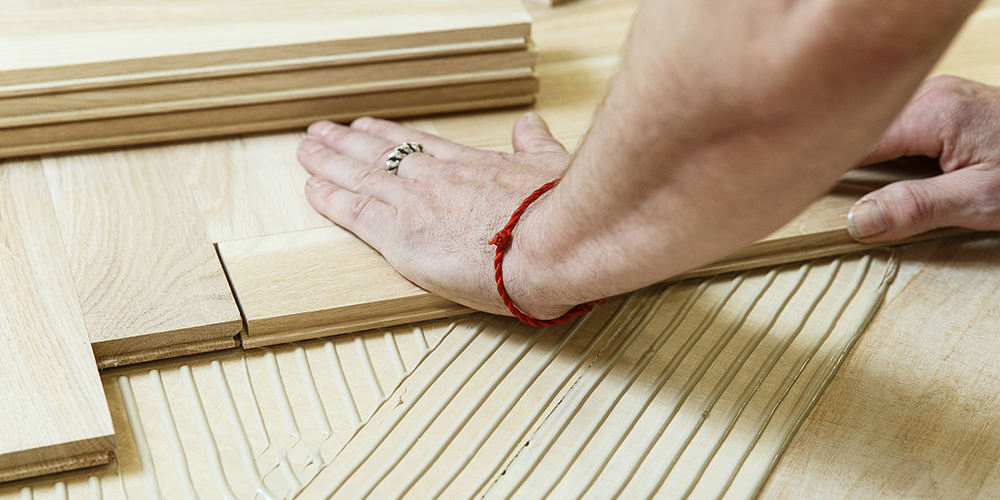Trust our experience!
Important to know
Floorboards and parquet are installed directly on a smooth, stable and dry subfloor. The subfloor can be made out of plywood, OSB plates, or concrete. Particular attention must be paid to the surface of the concrete: the top layer might have dried out while remaining soft inside. Concrete dries at a speed of 1 cm/month, but additional drying factors may be introduced to speed up the process, such as heating, dehumidifiers etc. In the case of concrete flooring, you must make sure that it has the appropriate moisture content and hardness. Before assembling the floor, it is important to complete any work in the room that can produce additional moisture (plastering, installation of tiles etc.). Concrete flooring has a high moisture absorption capacity, and the performance of such work will cause the concrete to absorb a excess moisture.
In new buildings, during the heating season, heating must be connected at least 2 to 3 weeks before the parquet flooring is installed in the premises.
About heated floors
Parquet flooring can also be installed on heated floors. Nevertheless, if the heated floor under the parquet is the only source of heating in the room, we recommend considering its effectiveness, since wood is a good thermal insulator and the heated floor on which the parquet is installed will not be able to ensure maximum heating during the winter season.
We recommend choosing narrower parquet boards for heated floors, because narrow boards shrink less than wide boards, therefore the cracks will remain unnoticeable during the heating season.
Catalogue of patterns
With the help of Vidrižu Atvari, anyone can discover their artistic talents by creating unique patterns according to their taste and plan for their bedroom, office, hall or any other room. Due to the high precision in sizing, as well as the wide range of shapes and proportions of parquet boards, we can create beautiful and original patterns with ease, finding original and unorthodox solutions without limiting your creativity.
We recommend browsing through the Vidrižu Atvari parquet pattern catalogue: it has something for everyone, and perhaps you will discover flooring perfect for your home!
Maintaining parquet flooring
Freshly varnished or oiled floors must be treated with special care for 8 to 14 days (depending on the material of the finish). The drying period will increase if the room has poor ventilation or if a thicker layer of varnish has been applied. Hardening agents, such as resins, polyurethane or acryl, evaporate as they dry, so the room must be thoroughly ventilated.
Let the floor rest during the initial period. The less you use the floor in these first days, the longer it will last later on. After 2 weeks, the floor must be washed for the first time using a maintenance and care product that provides additional protection.
To prevent scratching the flooring, we recommend attaching felt pads to table and chair legs. Special soft wheels should be used on armchairs and office chairs. Special rugs can be placed under wheeled furniture.
Avoid direct contact of sandy footwear with flooring as far as possible. If the wooden floors are used heavily, it will require increased care and continuous renewal of the protective coating.
Wooden floors: varnished or oiled?
Varnished wooden floors
The top layer of such flooring is covered with an invisible layer that prevents dirt from adhering and moisture from being absorbed into the wood. The main benefit of varnishing is easier day-to-day maintenance.
In cases where vacuuming the floor is not enough and the floors have to be washed, use a mop and clean water. Adding a special cleaning product to the water will help you remove grease or dirtier areas, but this is not always necessary.
By vacuuming the floor and washing it as necessary, the floor will serve you for many years, but you should keep in mind that over time, the layer of varnish will wear off and require reapplication. This is the disadvantage of varnished wood floors, because the layer of varnish will have to be reapplied on the entire surface of the floor. It is not possible to reapply varnish to specific worn-down or scratched areas only, since the gloss of the new varnish will differ from that of the previous layer. For this reason, if the varnish has to be restored, all furniture will have to be removed from the room and the process is bound to create a lot of dust.
The life of one layer of varnish depends on the intensity of floor use, and normally ranges from 2 to 5 years in corridors, halls and kitchens, and 15 to 20 years in bedrooms and similar rooms with low stress.
Oiled wooden floors
This type of flooring is protected from dirt and moisture by oil that penetrates into the wood, making the surface dense, thereby protecting the wood from the inside. If you go for the oiled floor, you will be able to fully enjoy the natural feel of the flooring, feeling the natural texture of the wood with your bare feet. Oil enhances the natural pattern of the wood, and the texture will stand out visually and feel nice to the touch. Maintaining oiled flooring requires special cleaning products, which are added to water; furthermore, depending on how heavily the floors are used, we recommend renewing the protective layer of oil using a special product that enriches the oil and improves the dirt-repulsing properties of the wood surface once every 3 to 6 months. The same product can also be used to repair scratches on the floor.
If an oiled floor is properly maintained, the need to sand the surface may arise only if significant mechanical damage, such as large scratches or dents, have appeared on the floor and it has lost its visual appeal.
In a nutshell
Conclusions from the above suggest that varnished wooden floors are easier to maintain and require less investment, but, if a scratch has to be repaired or the varnish must be restored, you will have to reapply varnish to the entire floor. On the other hand, owners of oiled floors can enjoy the natural feel of wooden flooring, while day-to-day maintenance is more time-consuming. However, repairing a scratch on the floor will be quite simple in comparison to varnished flooring.
Parquet flooring use conditions
1. Parquet flooring may be used 8–14 days after is treated with varnish or oil.
2. We do not recommend placing carpets on treated floors during the first few days after the treatment. When carrying out further finishing works, it is prohibited to cover the floor with polyurethane film, since it prevents the treatment agents from drying properly (varnish, oil). Soft cardboard may be used instead of film. Furniture and other household items must be carried and placed in the room carefully. We recommend sticking felt pads to table and chair legs to prevent scratching the floor as furniture is moved.
3. It is permitted to treat parquet flooring with parquet care products, but no sooner than 10 days after coating the floors in oil or varnish.
4. Air humidity damages wood floors, therefore it is crucial to ensure proper air humidity. The recommended air temperature is +18oC to +23oC and the relative humidity is between 30% and 55%. Air humidity tends to be higher in summer and lower in winter, and flooring that swells in the summer season will develop small gaps in the winter. Stable air humidity leads to longer life of parquet flooring. We highly recommend using air humidity sensors to adjust the climate in the room. During the winter season, when air humidity drops below 30%, we recommend using air humidifiers.
5. it is prohibited to wash parquet flooring washed with a wet mop! Use a damp mop instead.
If you observe these conditions, your parquet flooring will look beautiful and as good as new for years to come.
Rules for installing parquet flooring
1. The client undertakes to transfer the base floor to the contractor in a clean and even condition, with an appropriate moisture content of up to 2% for concrete, and up to 10% for wood.
2. Unevenness in the surface must not exceed 3 mm per 3 (three) metres.
3. The contractor assumes no responsibility for any deficiencies in the construction of base floor, provided that the contractor has not installed the base floor.
4. The client undertakes to ensure the relative air humidity of rooms to be within a range of 30% to 40% and the temperature within a range of +18oC to +22oC during the installation of parquet.
5. The client transfers a partially prepared room to the contractor. The room must have sufficient lighting; an electric power supply (220 V) must be available.
6. The client ensures that any other work that could disrupt the installation and sanding of the parquet, as well as its treatment with varnish or oil, is ceased; such work may include painting or installation of tiles, any work related to moisture, work that creates dust, since all of these can affect the parquet installation technology.
7. During the installation of parquet and thereafter, the client ensures that no unauthorised person walks on the newly installed parquet and/or performs any type of activity on it.
8. The client provides the contractor with all the required information and technical drawings related to the utilities under the floor (pipelines, cables etc.).
9. Before beginning the work, the client, together with the contractor, must measure the relative moisture of the base floor and the air humidity of the rooms and record the results in a report with the signatures of both parties in two copies.
10. The client’s representative must be present during the installation of parquet to control the process. The client may express his/her opinion, complaints relating to the installation of parquet, the pattern and colour of the parquet boards by informing the responsible person.
11. After the installation of the parquet and before the varnishing thereof, the client must inspect the installed parquet flooring and express his/her complaints regarding the quality of parquet installation, but without pointing out any problems regarding the pattern and/or colour of the parquet boards.
12. If such complaints are issued, both parties must reach an agreement concerning these problems before coating the parquet with varnish or oil.
13. After the parquet is coated with varnish or oil, the client is not entitled to raise claims against the pattern and/or colour of the parquet boards.



